8 Stan Store Alternatives to Help Boost Your Sales Today

For creators looking to capitalize off their brand, platforms like Stan Store have become popular tools for selling digital products, memberships, courses, and more, giving creators an easy way to monetize their content and engage directly with their audience.
As more creators look for ways to turn their passions into income, choosing the right platform has never been more important. While Stan Store offers a simple and effective solution, many creators are now exploring alternatives that provide greater flexibility, advanced features, or more competitive pricing.
In this article, we dive into the top Stan Store alternatives for 2025, showcasing options that help creators sell digital products, build memberships, and generate passive income. From Fourthwall to Gumroad, we’ll break down the key features, pricing, and benefits of each platform to help you make the best choice for your business.
What is Stan Store?
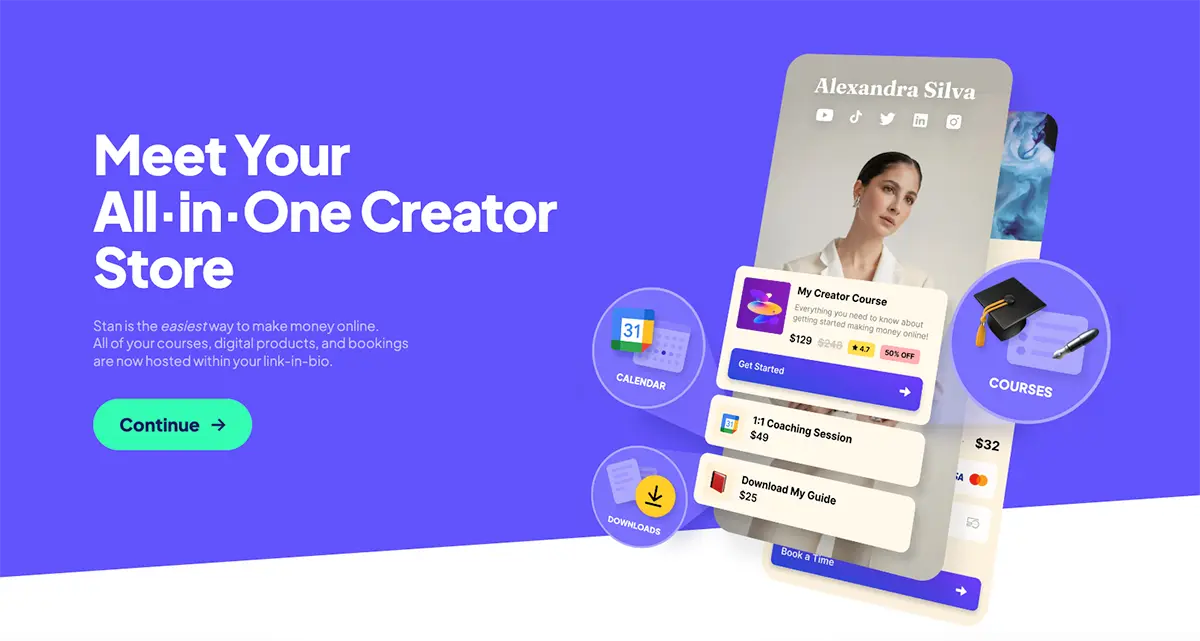
Stan Store is a monetization platform designed specifically for content creators, influencers, and entrepreneurs who want to sell digital products, manage subscriptions, and offer digital memberships.
The platform allows creators to quickly set up an online storefront without the need for complicated e-commerce integrations. Its simplicity makes it ideal for beginners, but for creators looking to scale, Stan Store may lack certain advanced features like deep customization or robust analytics.
While Stan Store is excellent for starting out, some creators may need more flexibility as they grow their digital product offerings or look for more tailored options.
Why Consider a Stan Store Alternative?
While Stan Store offers a solid platform for creators looking to sell digital products through a link-in-bio storefront, there are several reasons why creators might explore alternative platforms:
- Pricing Flexibility: Although Stan Store has a two-tier subscription model with no transaction fees, the $29 and $99 monthly plans may not be cost-effective for all creators, especially those with smaller audiences or inconsistent sales. Many alternatives provide more flexible pricing, including free plans with pay-as-you-go options, which can be more manageable for creators at different stages.
- Advanced Customization: Stan Store’s customization options are somewhat limited, particularly when it comes to full website branding and design. Creators who need more control over their storefront’s look and feel or who want to create a fully branded experience may find Stan Store's customizable themes and templates restrictive. Many alternatives offer extensive customization, allowing creators to tailor their digital storefronts to their unique brand fully.
- Product Limitations: One of Stan Store's biggest drawbacks is its focus solely on selling digital products like eBooks, courses, and digital downloads. For creators looking to expand their product offerings into physical goods—such as apparel, accessories, home decor, or consumables—Stan Store falls short. Many alternative platforms provide built-in support for selling both digital and physical products, offering features like print-on-demand services and inventory management. This flexibility allows creators to design and sell custom merchandise, from t-shirts and phone cases to mugs and candles, without needing third-party integrations.
- Integration Features: Stan Store includes basic marketing and sales tools, but some alternatives provide deeper integrations, like shoppable content on social media. For creators looking for seamless integration with features like TikTok Shop, YouTube Shopping, or Twitch Gifting, alternative platforms might be a better fit.
Key Factors to Consider When Choosing a New Platform
When choosing an alternative to Stan Store, it's essential to evaluate several key factors that will impact your long-term success as a creator. Here's a comprehensive look at what to consider:
Budget and Pricing
Consider not just the upfront costs but how the platform’s pricing model aligns with your growth plans. Many platforms offer tiered pricing based on the features you need, starting with low-cost or freemium options that scale as your business grows.
It’s crucial to examine potential hidden fees, such as transaction or service charges, which could increase as your sales volume rises. Ideally, choose a platform that allows you to transition to more robust plans without experiencing a sharp price hike, ensuring that you can grow your business without financial strain.
Product Offerings
Platforms vary significantly in the types of products they support, so choose one that accommodates your current and future offerings. If you’re beginning with digital products like eBooks or courses, a platform focused on digital sales may be enough.
However, if you plan to expand into physical goods—such as apparel, accessories, or home decor—ensure the platform also supports these products. Features like print-on-demand services can be valuable for creators wanting to sell physical merchandise without managing inventory.
Flexibility to offer memberships, subscriptions, or live-stream events is also important for creators building a loyal fan base, as it allows for multiple revenue streams.
Target Audience
Your audience’s shopping preferences should be a top priority when selecting a platform. Some platforms cater more to fans of digital goods like eBooks, digital art, or courses, enhancing their purchasing experience.
If your audience prefers tangible products like custom apparel or home decor, a platform that strongly supports physical product sales is essential.
Additionally, ensure the platform integrates seamlessly with social media channels like Instagram, TikTok, or YouTube, where your audience may discover and engage with your brand. A platform that aligns with your audience's shopping habits will make it easier to attract and retain customers.
Ease of Use
Depending on your technical skills, the ease of use of the platform will play a significant role in your day-to-day operations.
Some platforms are highly user-friendly and require minimal setup, perfect for beginners, while others may require a bit more technical know-how.
Evaluate how intuitive the platform is in terms of creating products, managing sales, and customizing your storefront.
Customization and Branding
If branding is important to your business, you’ll want a platform that offers extensive customization options.
Look for a balance between customizability and ease of use—too much complexity can become overwhelming, but limited customization might restrict your ability to represent your brand effectively.
Ensure the platform allows for flexible design, branding options, and custom domains to create a consistent experience for your customers.
Integrations with Tools
Many creators rely on third-party tools for social media marketing, email campaigns, or customer relationship management.
Make sure the platform integrates with your existing tools or any tools you plan to use. This can include integrations with email marketing platforms like Mailchimp, social media platforms for shoppable content, or e-commerce integrations like PayPal, Stripe, and others for smoother payment processing.
Customer Support and Community
Responsive customer support can make a significant difference when you encounter technical difficulties or need help optimizing your store.
Choose a platform with solid customer support channels, whether via live chat, email, or a dedicated help center. Additionally, a platform with an active user community can provide valuable insights and advice, helping you troubleshoot issues or discover new growth strategies.
By carefully considering these factors, you can find a platform that not only meets your current needs but also helps your business grow in the long term.
Top 8 Stan Store Alternatives for 2025
For creators seeking more advanced options or specific features that Stan Store may not offer, the following alternatives are excellent choices.
1. Fourthwall

Fourthwall stands out as a powerful alternative to Stan Store, offering creators a comprehensive suite of tools for monetizing their content, selling products, and building their brand online.
Unlike Stan Store, which focuses mainly on digital goods, Fourthwall allows creators to easily manage merchandise fulfillment without worrying about inventory or shipping.
The platform provides a comprehensive set of tools that allow you to build your own customized website and online shop without any coding. You can seamlessly display your content, merch, and social media platforms all on one site, creating a central hub for your audience.
Fourthwall also enhances the shopping experience with advanced social media integrations, such as Twitch Gifting, Instagram Shopping, TikTok Shop, and YouTube Merch Shelf, enabling creators to sell directly to their audiences.
Streamers also benefit from Fourthwall's integration with StreamElements and StreamLabs, which allows them to receive real-time alerts for product purchases during live streams and adds interactivity to their content.
Additionally, Fourthwall supports comprehensive membership features, enabling creators to create posts that anyone can view but only members can interact with. It also accepts donations and offers multiple payment options, such as PayPal, Klarna, and Apple Pay.
With the ability to create fully branded custom apps, built-in analytics, and integration with email marketing tools such as Klaviyo and beehive, Fourthwall gives creators the flexibility to grow their business, engage deeply with their audience, and enhance their brand presence.
Pricing: Fourthwall does not require any upfront fees or annual payments to sign up and only charges a 5% transaction fee on all sales.
2. Sellfy
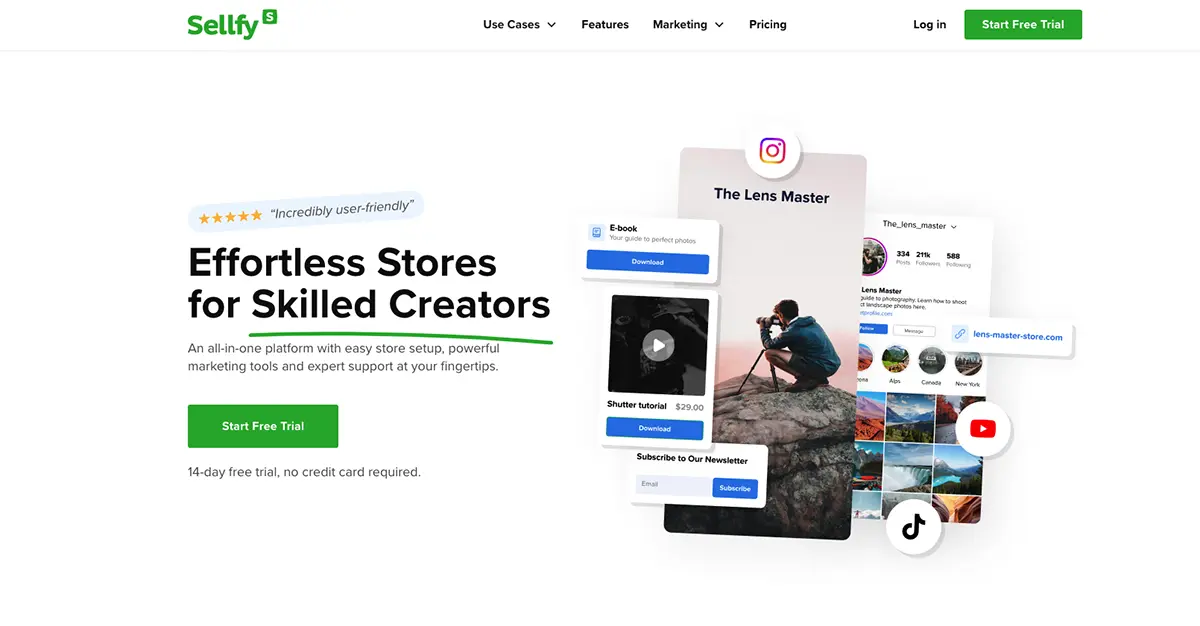
Similar to Fourthwall, Sellfy is an all-in-one platform that allows creators to sell both digital and physical products.
With its simple setup process, creators can quickly launch their online store, customize it with various themes, and even embed the store on their own websites.
Sellfy offers built-in marketing tools such as email automation, upselling features, and abandoned cart recovery, helping creators maximize their sales and grow their audience effortlessly.
For those interested in selling physical products, Sellfy provides integrated print-on-demand services, allowing creators to sell merchandise without managing inventory or shipping.
In terms of pricing, Sellfy offers competitive plans starting at $22/month, with higher tiers unlocking advanced features like cart abandonment and branding removal.
This combination of simplicity, robust marketing tools, and support for both digital and physical products makes Sellfy a top choice for creators looking to scale their business efficiently.
Pricing: Starter plan begins at $22/month, or you can pay annually for $264/year.
3. Podia

Podia is an exceptional alternative to Stan Store for creators seeking to monetize their content through digital products, online courses, and memberships.
This all-in-one platform provides an easy-to-use interface for building customizable storefronts and course websites. It features drag-and-drop functionality and professionally designed templates.
Podia stands out with its powerful tools for creating online courses, offering features like video uploads, quizzes, drip content, and pre-selling capabilities.
Additionally, the platform integrates seamlessly with payment processors like PayPal and Stripe while offering email marketing tools, affiliate marketing, and community-building options to engage and grow your audience.
With flexible pricing plans, including a free start-up option, Podia gives creators everything they need to scale their businesses and build lasting relationships with their supporters.
Pricing: Podia provides a free plan and three other tiered membership programs. However, the free plan charges a 10% transaction fee, which can be considerably high.
4. Gumroad
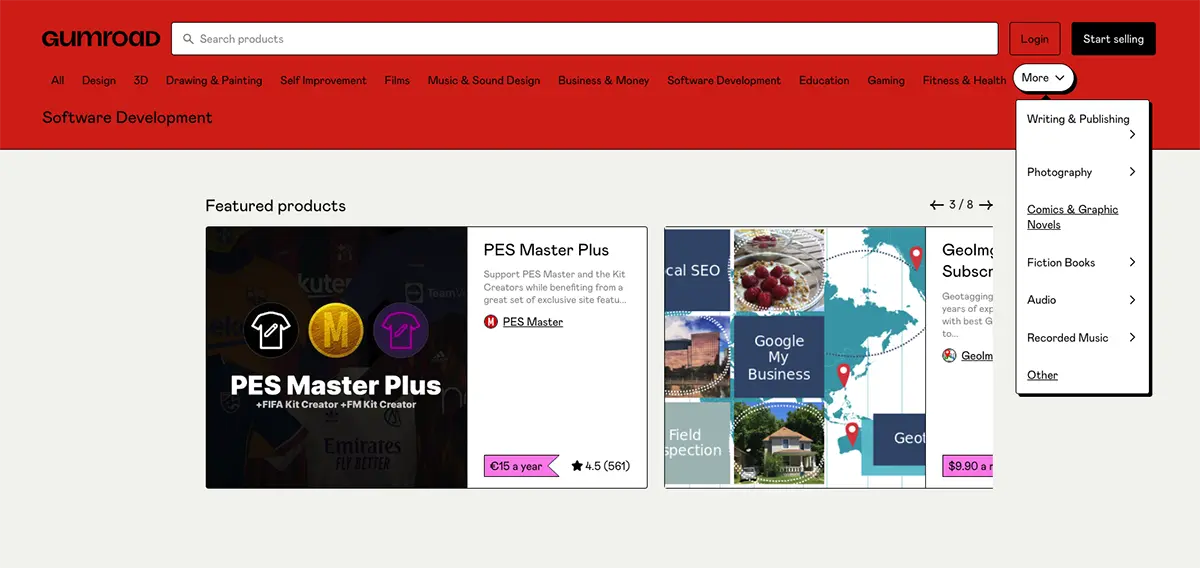
Gumroad has established itself as a popular platform for creators and digital entrepreneurs looking to sell various digital products.
Gumroad’s straightforward, user-friendly interface allows creators to set up their storefront and begin selling almost immediately without needing any coding or technical knowledge.
This platform is ideal for creators who want to focus on selling downloadable digital products like eBooks, courses, design assets, software, templates, audio, and even coaching services.
With Gumroad, creators can sell their products directly from a personalized Gumroad URL or embed them on their own websites, making it highly versatile for a wide range of digital offerings.
Gumroad further supports its users with customizable product pages, automated delivery of digital goods, and powerful email marketing and analytics tools, helping creators maximize their profits and engage with their audience effectively.
Integration with popular tools like Zapier and Mailchimp allows for further automation and streamlined operations. Moreover, Gumroad's built-in affiliate management system makes it easy for creators to set up affiliate programs and boost their sales reach.
Pricing: The platform has no upfront monthly fees and only charges a 10% transaction fee on each sale.
5. Shopify
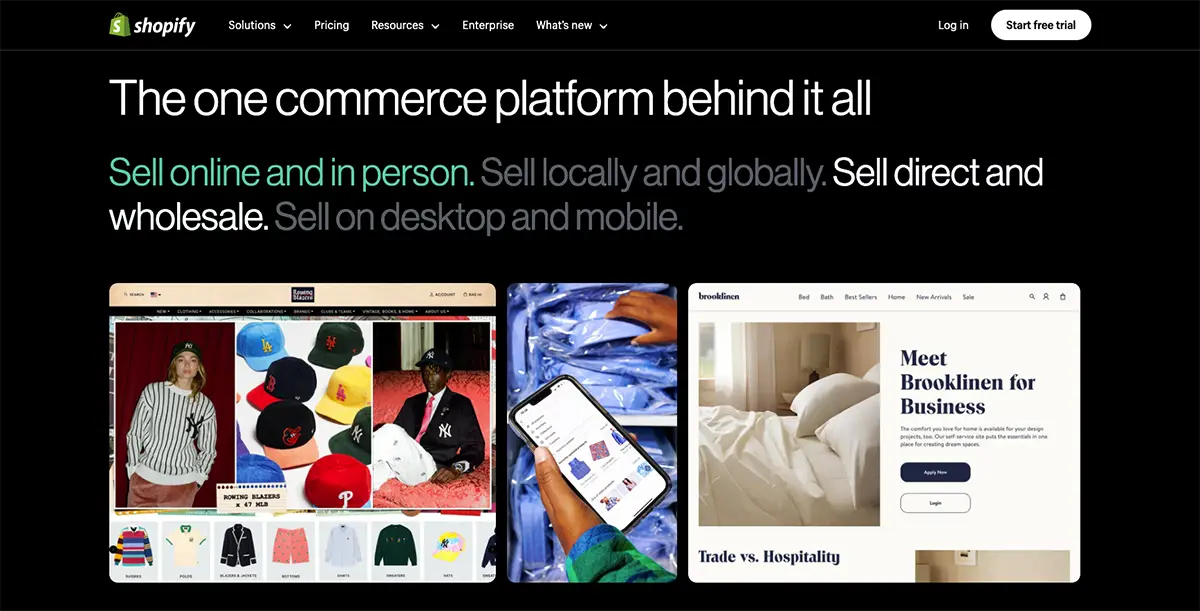
Shopify is a powerful ecommerce platform that provides creators with complete control over their online store, making it an ideal alternative to Stan Store for those looking to scale their business.
Shopify offers extensive customization options, allowing creators to design and brand their storefronts with a drag-and-drop builder and a wide range of customizable templates.
With millions of merchants and a significant share of the U.S. e-commerce market, Shopify excels in supporting both physical and digital product sales.
Its advanced integrations with various payment processors, third-party apps, and marketing tools enable creators to manage everything from inventory to shipping to analytics with ease.
Shopify's vast app ecosystem allows creators to enhance their stores with powerful features, from customer relationship management (CRM) to SEO tools.
While Shopify does have monthly fees that range from $29 to $299 depending on the plan, its scalability, flexibility, and robust features make it a top choice for creators ready to grow their business beyond digital products.
Pricing: Shopify's Basic plan starts at $29/month.
6. Ko-fi
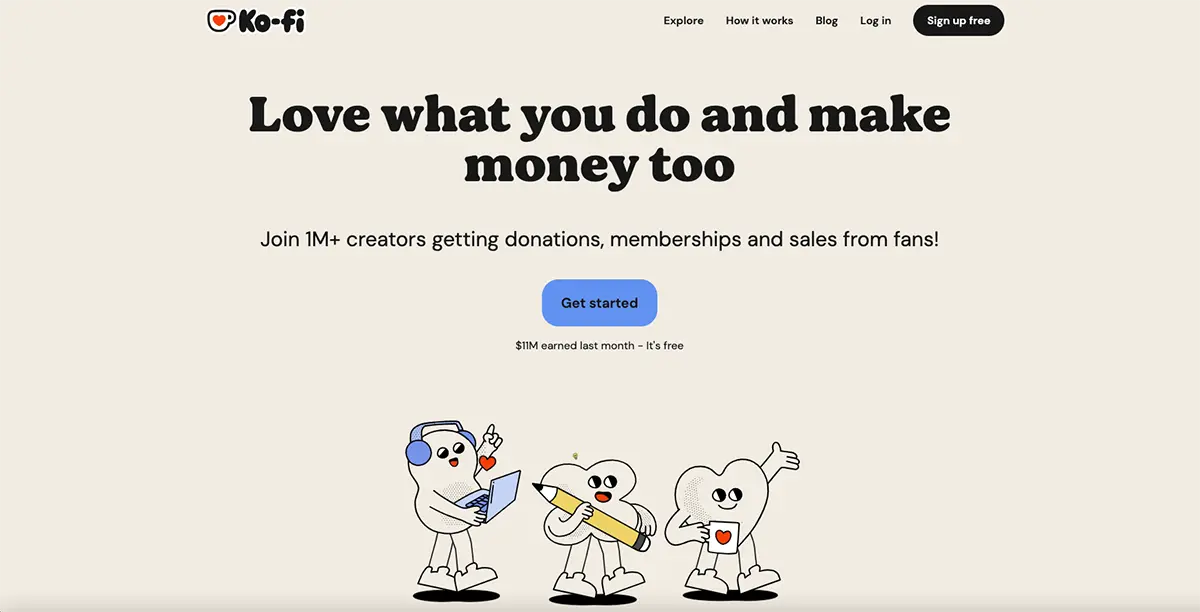
Known for its simplicity and creator-friendly approach, Ko-fi allows creators to set up a shop, start crowdfunding projects, and receive donation alerts during live streams.
It offers a low-cost entry point with a free plan that charges a 5% platform fee, while the Ko-fi Gold plan—priced at just $6 per month—eliminates transaction fees, making it an affordable option for creators of all levels.
Ko-fi is particularly well-suited for artists, writers, and creators selling smaller digital products or seeking to monetize their fanbase through memberships and donations.
The platform also supports commissions, which is ideal for creators who take custom requests. With built-in discoverability features, Ko-fi makes it easier for fans to find and support creators, further enhancing the platform's appeal.
Whether you're just starting or looking to grow your digital business, Ko-fi’s flexible, low-cost pricing model and strong support for creative endeavors make it a highly attractive option.
Pricing: Signing up and joining is free. However, the platform charges a 5% fee on all shops and commission income.
7. Lemon Squeezy
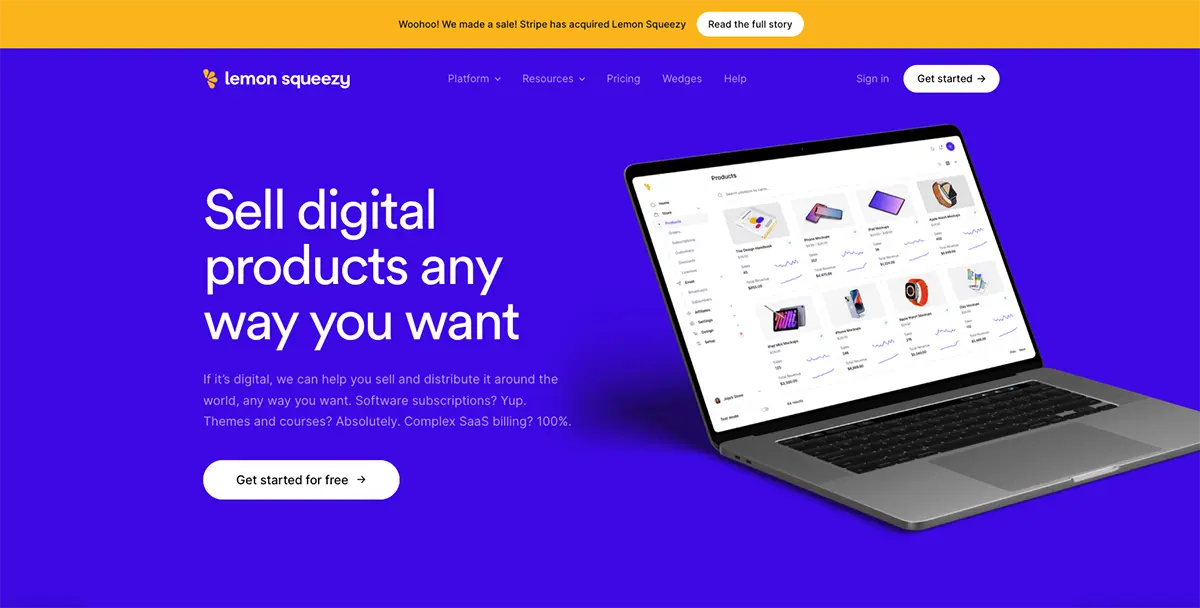
Lemon Squeezy's user-friendly interface makes it easy for creators to sell various digital items, such as eBooks, templates, audio files, and PDFs.
One of the platform's standout features is that it acts as a merchant of record, handling global tax compliance on behalf of its users and freeing creators from the complexities of managing taxes across different countries.
Lemon Squeezy also offers robust payment processing options, including credit card and PayPal, as well as subscription management tools for recurring payments.
Additionally, the platform includes built-in fraud prevention, a developer API for integrations, and a powerful dunning system to manage failed payment recovery.
With its free eCommerce plan and affordable email marketing options, Lemon Squeezy is an ideal solution for creators looking to start or scale their digital product business without the hassle of technical complexities or tax burdens.
Pricing: Lemon Squeezy does not charge a monthly plan. However, it does take a %5 + 50 cent cut on each sale you make.
8. Patreon

Known for its popularity and reliability, Patreon has been a go-to for creators looking to monetize their content through a membership-based platform.
Known for its focus on building recurring income, Patreon allows creators to set up subscription models where fans, known as Patrons, pay for access to exclusive content.
This content can range from early access to behind-the-scenes updates, personalized rewards, and multimedia offerings like video and audio.
Patreon offers flexible membership tiers, letting creators decide the benefits that Patrons receive at each level. This makes it a great way to build a dedicated community.
The platform also provides powerful analytics to help creators track engagement and optimize content offerings.
With low transaction fees starting at 5% and higher-tier plans offering additional features at 8% or 12%, Patreon is a robust option for creators seeking to turn their biggest fans into a sustainable source of income.
Pricing: Patreon is free to use but charges a significant transaction fee and an additional payment processing fee.
How to Transition from Stan Store to a New Platform
Moving your store from Stan Store to a new platform may seem daunting, but with the right steps, it can be a smooth transition.
Step 1: Evaluate Your Needs
Before switching from Stan Store or choosing an alternative, it's crucial to evaluate your specific business requirements. Start by identifying the features and tools that Stan Store might lack and that are essential for your growth.
For example, if you're looking for more in-depth branding options, you might need a platform that allows for full website customization so your storefront can reflect your unique brand identity beyond simple templates.
Additionally, if data-driven decisions are essential to scaling your business, you may need advanced analytics to track customer behavior, sales trends, and marketing effectiveness.
By clarifying these needs upfront, you can better match potential platforms with your business goals and avoid limitations down the line.
Step 2: Migrate Your Products
Migrating your digital products, customer data, and sales records from Stan Store to a new platform requires careful planning to ensure a smooth transition.
Begin by exporting all relevant data from Stan Store, including your product files (e.g., eBooks, courses, or digital downloads), customer lists, and historical sales records. Most platforms allow you to download this data in CSV or other transferable formats.
Once you have this information, familiarize yourself with your new platform's import tools to ensure compatibility and avoid data loss. Some platforms may offer automated migration tools, while others may require manual input.
During the process, it's also essential to review and reorganize your product listings, ensuring that your pricing, descriptions, and categories align with the new platform’s format. This is also a great time to enhance your offerings—such as by updating product images or adding new features—to make the most of the move.
Finally, communicate the migration to your customers, ensuring they know where to find your products on the new platform.
Step 3: Inform Your Audience
Once the migration is underway, it's crucial to keep your audience informed.
Use email campaigns, social media, and any other communication channels to announce your move to a new platform.
Explain the benefits they’ll experience with the transition, such as improved shopping experiences, more payment options, or new products.
Offering a special promotion or discount for early purchases on your new platform can incentivize customers to visit and engage with your store quickly.
Be sure to clearly communicate where they can find your new storefront and reassure them that their account details and purchase history are safe and transferred where possible.
Step 4: Test and Optimize
Before fully launching your new store, it's essential to test everything to ensure a smooth experience for customers.
Start by testing key functionalities, such as payment gateways, product downloads, and customer logins. Check for any potential issues with shipping options (if applicable), discounts, or product visibility.
Go through the entire purchase process from a customer’s perspective, ensuring that all transactions run smoothly from browsing to checkout. This is also the time to make any final adjustments, such as optimizing product categories, refining your SEO strategies, and ensuring that your website is mobile-friendly.
Thorough testing will help you identify and fix any issues before launching to the public, ensuring a seamless transition for your customers.
Start Selling Your Products with Fourthwall!

Ready to elevate your business?
Fourthwall is the all-in-one platform designed for content creators to seamlessly sell digital products, memberships, and merchandise.
With Fourthwall, you can create a fully customizable, professional store, complete with high-quality product images and optimized for maximum visibility.
The platform’s integrated marketing tools, social media integrations, and membership features make it easy to manage everything from one intuitive dashboard.
Plus, Fourthwall offers multiple payment options and built-in analytics, helping you grow your business while staying focused on your creative work.
Sign up today to take advantage of these powerful tools and start selling with ease.
Frequently Asked Questions
What’s the Difference Between Private Label and White Label Products?
Private label products are manufactured by a third party but designed specifically for your brand. They allow you to customize the packaging, design, and sometimes even the product itself to align with your brand’s identity, giving you more control over how your customers perceive the product.
On the other hand, white label products are pre-made, generic items that multiple brands can sell with no or minimal customization, making them quicker to market but less personalized.
For a more in-depth comparison and guidance on choosing between private label and white label products for your brand, check out this blog.
How Do I Choose the Right Platform for Selling Digital Products?
When choosing the right platform for selling digital products, consider how well it caters to your audience's needs and shopping preferences.
Ensure the platform offers robust customization options, allowing you to design a storefront that reflects your brand’s identity.
It's also important to select a platform that integrates with social media channels and marketing tools. This will help you reach a broader audience and streamline your promotional efforts.
Additionally, evaluate features like payment options, analytics, and ease of use to ensure the platform can grow with your business.
How Can I Maximize Profit from Digital Product Sales?
To maximize profit from digital product sales, utilize email marketing to engage your audience with targeted campaigns, promoting new products, special offers, and personalized recommendations.
Incorporate upselling techniques by suggesting higher-value products or add-ons during the checkout process. Use discount codes strategically to incentivize repeat purchases without devaluing your brand.
Moreover, you should regularly review and adjust your pricing to reflect the value of your products, ensuring they remain competitive in the market while aligning with your audience's willingness to pay.
















